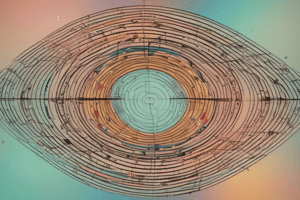Podcast
Questions and Answers
What is the purpose of decomposition of a rational function?
What is the purpose of decomposition of a rational function?
- To simplify the function (correct)
- To find the determinant of the function
- To graph the function
- To find the inverse of the function
The modulus function is an example of a signum function.
The modulus function is an example of a signum function.
False (B)
A _______________________ is a function that assigns to each real number $x$ the largest integer less than or equal to $x$.
A _______________________ is a function that assigns to each real number $x$ the largest integer less than or equal to $x$.
Greatest Integer function
What is the purpose of finding the inverse of a square matrix?
What is the purpose of finding the inverse of a square matrix?
Match the following concepts with their corresponding units:
Match the following concepts with their corresponding units:
Study Notes
Unit One: Relations and Functions
- Revision of relations includes understanding the concept of inverse of a relation.
- A function is a relation between a set of inputs (domain) and a set of possible outputs (range).
- Modulus function: a function that returns the absolute value of a number.
- Signum function: a function that returns -1 if the input is negative, 0 if the input is zero, and 1 if the input is positive.
- Greatest Integer function: a function that returns the largest integer less than or equal to the input.
Classification of Functions
- Functions can be classified as injective, surjective, bijective, and composite functions.
Unit Two: Rational Functions
- Simplification of rational functions involves cancelling out common factors between the numerator and denominator.
- Decomposition of rational functions involves breaking down a rational function into simpler fractions.
- Graph of rational function: a visual representation of the relationship between the input and output of a rational function.
Unit Five: Statistics and Probability
- Frequency distribution: a table that displays the frequency of each value in a dataset.
- Measure of location: includes mean, median, and mode.
- Quartile, decile, and percentile: measures of position that divide a dataset into parts.
- Permutation: an arrangement of objects in a specific order.
- Combination: a selection of objects without regard to order.
- Probability: a measure of the likelihood of an event occurring.
Unit Six: Matrices and Determinants
- Matrices: rectangular arrays of numbers, symbols, or expressions.
- Determinant: a scalar value that can be computed from the elements of a matrix.
- Inverse of a square matrix: a matrix that when multiplied by the original matrix, results in the identity matrix.
- Systems of linear equations can be solved using matrices and determinants.
Unit Seven: Vectors and Transformations
- Vectors: quantities with magnitude and direction.
- Scalars: quantities with magnitude only.
- Transformation of the plane: a change in the position or orientation of the plane, which can be represented using vectors and matrices.
Studying That Suits You
Use AI to generate personalized quizzes and flashcards to suit your learning preferences.
Description
Review of relations and functions, including inverse of a relation, domain, range, modulus, signum, and greatest integer functions.




